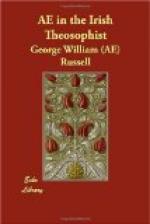My friend Felix was strangely disturbed; not only were his material affairs unsettled, but he was also passing through a crisis in his spiritual life. Two paths were open before him; On one side lay the dazzling mystery of passion; on the other “the small old path” held out its secret and spiritual allurements. I had hope that he would choose the latter, and as I was keenly interested in his decision. I invested the struggle going on in his mind with something of universal significance, seeing in it a symbol of the strife between “light and darkness which are the world’s eternal ways.” He came in late one evening. I saw at once by the dim light that there was something strange in his manner. I spoke to him in enquiry; he answered me in a harsh dry voice quite foreign to his usual manner. “Oh, I am not going to trouble myself any more, I will let things take their course.” This seemed the one idea in his mind, the one thing he understood clearly was that things were to take their own course; he failed to grasp the significance of any other idea or its relative importance. He answered “Aye, indeed,” with every appearance of interest and eagerness to some trivial remark about the weather, and was quite unconcerned about another and most important matter which should have interested him deeply. I soon saw what had happened; his mind, in which forces so evenly balanced had fought so strenuously, had become utterly wearied out and could work no longer. A flash of old intuition illumined it at last,— it was not wise to strive with such bitterness over life,—therefore he said to me in memory of this intuition, “I am going to let things take their course.” A larger tribunal would decide; he had appealed unto Caesar. I sent him up to his room and tried to quiet his fever by magnetization with some success. He fell asleep, and as I was rather weary myself I retired soon after.
This was the vision of the night. It was surely in the room I was lying and on my bed, and yet space opened on every side with pale, clear light. A slight wavering figure caught my eye, a figure that swayed to and fro; I was struck with its utter feebleness, yet I understood it was its own will or some quality of its nature which determined that palpitating movement towards the poles between which it swung. What were they? I became silent as night and thought no more.
Two figures awful in their power opposed each other; the frail being wavering between them could by putting out its arms have touched them both. It alone wavered, for they were silent, resolute and knit in the conflict of will; they stirred not a hand nor a foot; there was only a still quivering now and then as of intense effort, but they made no other movement. Their heads were bent forward slightly, their arms folded, their bodies straight, rigid, and inclined slightly backwards from each other like two spokes of a gigantic wheel. What were they, these figures?




